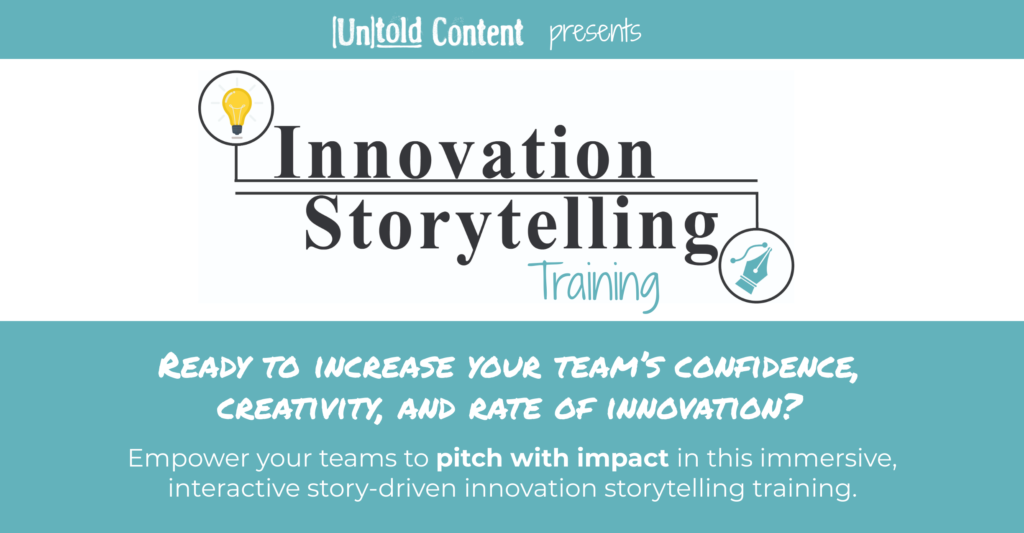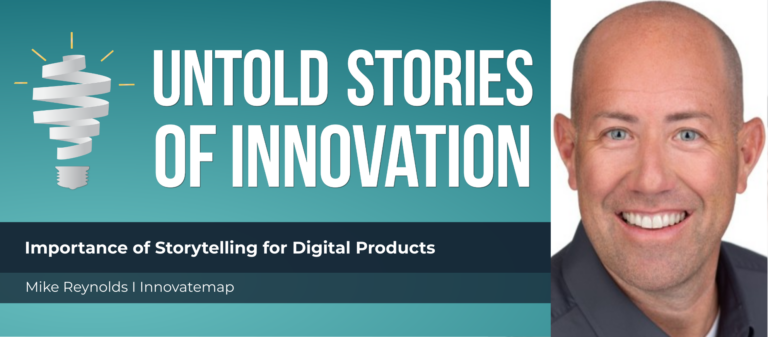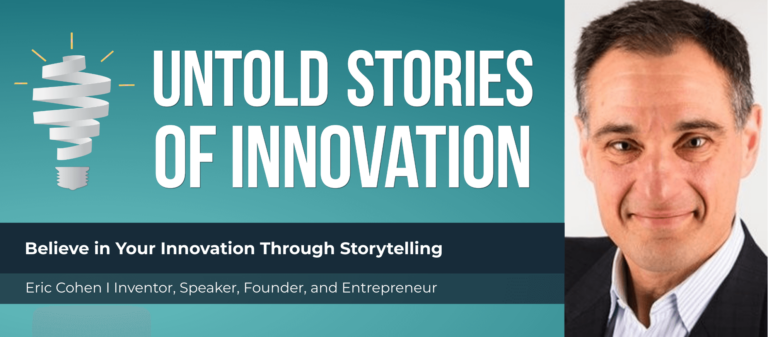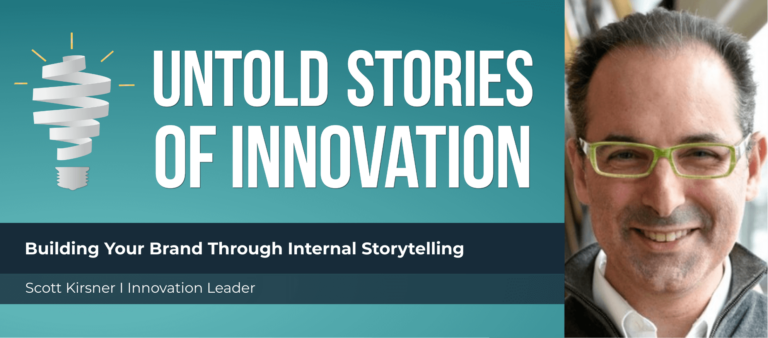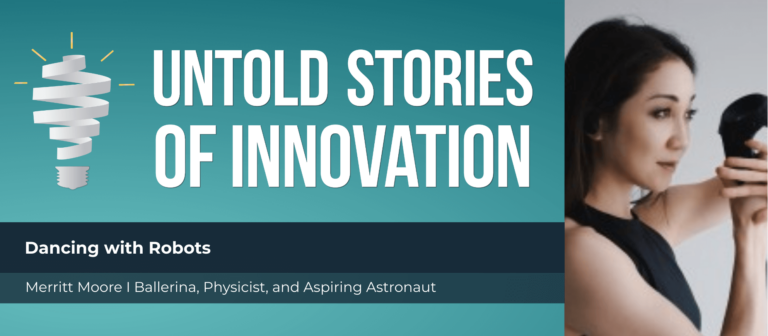Building Your Brand Through Internal Storytelling with Scott Kirsner
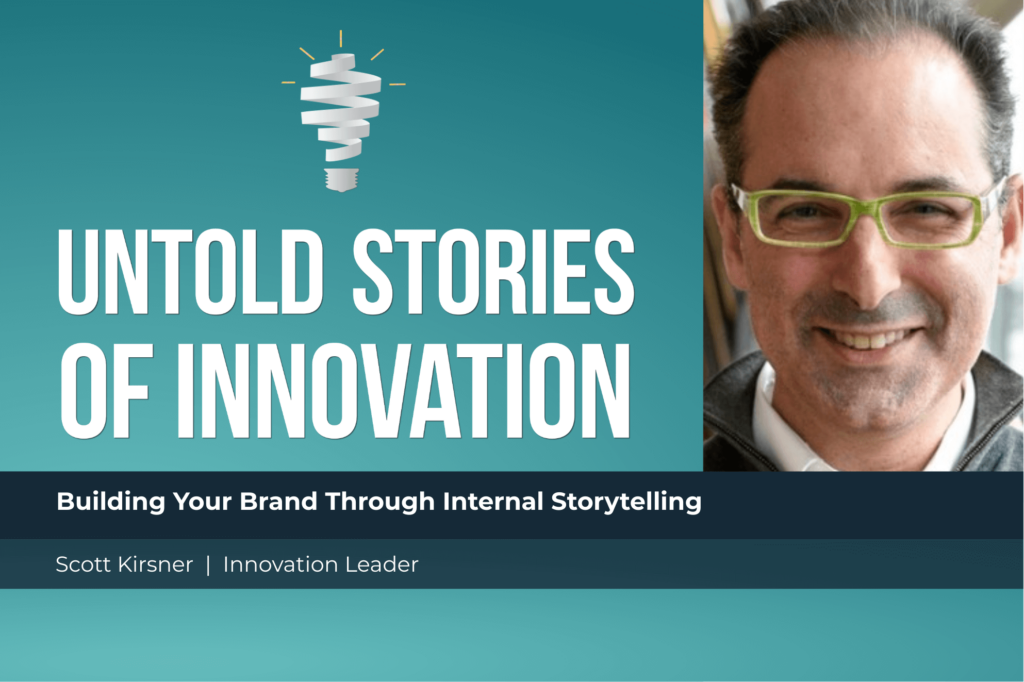
Building Your Brand Through Internal Storytelling - Untold Stories of Innovation
“We hear from former corporate innovators who basically say, ‘we didn't do enough. We didn't do enough internal storytelling. And that's one of the reasons that this initiative got shut down.’ I've had that conversation more than once, which is in retrospect: we should have done more, not not necessarily external storytelling and press releases, but just internal explanations about why the initiative exists, who we're trying to reach with this initiative, how you can be involved, and telling stories of success.”
— Scott Kirsner
From today’s episode you’ll learn:
Why do stories matter to the innovation process? What values can building your brand through internal storytelling instill in innovators who share stories? How do innovation leaders inspire creators to tell and share their success and failure stories?
We speak with Scott Kirsner, CEO of Innovation Leader, a media and events company focused on Chief Innovation Officers, senior R&D execs, and intrapreneurs at large organizations who are responsible for making change happen. He is also a weekly columnist for the Boston Globe. Find out from Scott why internal storytelling could be the difference between an initiative that is shut down and an initiative that has corporate backing. He also shares how building your brand through internal storytelling favors the first teller. Once someone owns a particular story in people’s minds, it’s very hard for the second player to come along and own that same story; therefore, it’s important to learn how to tell the innovation story best so it sticks in the audience’s minds. Tune in to our latest podcast episode for more insights!
Follow Scott Kirsner and Innovation Leader on social media! Facebook: https://www.facebook.com/kirsner, Innovation Economy Facebook Page: @innoeco, Twitter: @ScottKirsner and @InnoLead, and LinkedIn: @ScottKirsner and @InnovationLeader.

Scott Kirsner is currently growing Innovation Leader, a media and events company focused on Chief Innovation Officers, senior R&D execs, and intrapreneurs at large organizations who are responsible for making change happen. He is a weekly columnist for the Boston Globe: https://www.bostonglobe.com/contributors/skirsner, Co-founder and advisor to the Nantucket Conference on Entrepreneurship & Innovation (www.nantucketconference.com), and the Convergence Forum (www.convergenceforum.com). He is also editor of "The Convergence Guide to Life Sciences in New England"and Author of "Fans, Friends & Followers," "Inventing the Movies," and "The Future of Web Video." Scott is a speaker and moderator at events related to innovation and entertainment and has contributed to publications including the New York Times, Wired, Fast Company, Harvard Business Review online, CIO Magazine, the San Jose Mercury News, Newsweek, BusinessWeek, Salon, Variety, Boston Magazine, The Hollywood Reporter, and the Industry Standard.
This episode is powered by Untold Content’s innovation storytelling training. Increase buy in for your best ideas in this immersive and interactive, story-driven experience. Where your teams refine storytelling techniques for their latest projects, prototypes and pitches—and get inspired by 25 epic examples of impactful innovation stories. Learn more at untoldcontent.com/trainings/innovation-storytelling-training
Katie Trauth Taylor: [00:00:04] Welcome to Untold Stories of Innovation, where we amplify untold stories of insight, impact and innovation powered by Untold Content. I’m your host, Katie Trauth Taylor. Our guest today is Scott Kirsner. He is currently growing Innovation Leader, a media and events company, focused on chief innovation officers, senior R&D execs and entrepreneurs at large organizations who are responsible for making change happen. He’s the author of several books, including his latest called Innovation Economy, and he has been a weekly columnist for the Boston Globe writing articles about innovation, particularly in the Boston region, nearly since its founding. Scott, I’m so grateful to have you on the podcast today.
Scott Kirsner: [00:00:51] I’m so grateful to be here. Thanks.
Katie Trauth Taylor: [00:00:54] So you know a bit about storytelling for innovation.
Scott Kirsner: [00:00:58] Well, I’ve been trying to make a living doing storytelling around…. initially, a lot around startup innovation, because that’s what I was gravitating to. And then in these last six or seven years around innovation and new products and R&D inside bigger, more established companies.
Katie Trauth Taylor: [00:01:15] Yeah, I love the diversity and range of your focus. And I’ve been following your column in the Boston Globe for a while now. I think you’ve had the column for, what, 20 years at this point?
Scott Kirsner: [00:01:26] It’s been a little more than 20 years, which it seems like it’s gone by in a flash.
Katie Trauth Taylor: [00:01:32] It’s amazing. But you write so prolifically for The Globe. I think… You’re publishing – seem to be publishing – every few days fairly substantial articles, a lot about startup innovation as well as, like you mentioned, enterprise innovation and something I just want to dig right into your ability to create a narrative hook right from the title. At this point, I think you’re pretty much a master of that. Could you tell us a little bit about how you get ideas for the column and how you try to frame those stories in a way that pulls people in and helps facilitate energy and conversation around innovation?
Scott Kirsner: [00:02:13] Well, it’s such a good question. I mean, so the hook and getting started, I feel like is always the most challenging thing, right? Any time you have to create a storyboard or write something, a blog post or an article. And so I always just think after I’ve met people and done interviews and maybe visited places, I always try to talk to people in my life about what I’ve seen and think about, well, what is actually interesting to them about this, I’ve never aspired to be a science writer or a technical writer because I’m not that good and I’m not that detail-oriented. So I feel like… I feel like what I’ve learned is my strength is kind of if you were explaining this to someone at a backyard barbecue back when we had backyard barbecues, what is the piece of this that would really grab them? And I tend to start with that and use that as a hook. And, you know, so often it really can help to go places and see things happening for sure.
Katie Trauth Taylor: [00:03:24] Yeah. So it’s funny we come at this from two maybe different lenses, because I am the scientific and technical writer and I love the… I love that we’ve already kind of arrived at that juxtaposition between the really technical content and the more journalistic content. And I think even really good technical writing really should do the same thing if you can’t explain it the way that you would at a barbecue. I love that metaphor. You know, even highly technical information can mystify or create confusion if you don’t at least try to pursue a strong hook, pursue relatability.
Scott Kirsner: [00:04:03] Yeah, I think about one of the one of my favorite stories, because it could have been a science writing story and it could have also been an innovation story, was a piece I wrote about kind of the creation of the Cambridge biotech cluster here in Massachusetts, and it was called, “How Cambridge Became the Life Sciences Capital.” And I kind of felt like there was this moment and I think it was in 1975 or 1976 when a debate sprang up in Cambridge over should you be allowed to do scientific experiments using recombinant DNA technology? And there was a lot of fear that somehow these manipulated DNA strands would the lab rats from these labs would get out and carry viruses or that maybe the labs would be creating Frankenstein monsters. So a lot of people in Cambridge were freaking out about Harvard and MIT wanting to do these experiments with recombinant DNA. And one weekend there was I think the Harvard Crimson had written about this, but there was kind of an information fair or information tables that were set up in Kendall Square. And there was a pro table and a con table, and there were, I think, students manning both of those tables, you know, “yes, we should be allowed to do these experiments at our universities” or, “no, not let’s not do the experiments. Maybe we could do them in the desert of New Mexico, the same way we developed atomic bomb technology, really far from people.” And to me, that felt like the hook that moment of the summer of ’76. And it was …it’s a place that people in Boston know. And you can kind of imagine the students being really engaged and activated around this debate. And I was able to catch up with one of the students who manned the “con” table, who was against the experiments happening in Cambridge. And lo and behold, he lives in California and he’s a biotech entrepreneur now.
Katie Trauth Taylor: [00:06:04] How funny did he say what that journey, how his mindset shifted over time?
Scott Kirsner: [00:06:10] Well, yeah, he did. And, you know, he was kind of interested in really just the dynamics of the debate and sort of really pushing the questions of what could go wrong here with these experiments, where should we do them? But it just, it’s like you always are looking for that hook to start the story in an engaging way where people can plug in and relate to it in some way: there’s a place they know or there is a tension and a debate happening. And then this guy, his name is Scott Thatcher. He gave me the perfect ending because he now comes to Cambridge as a representative of this biotech startup looking for venture capital funding. And so that kind of let me end the story in a way to say, hey, this has become basically the world capital of life sciences now. And even people who were not sure we should be doing this research in Cambridge now come here to try to raise money.
Katie Trauth Taylor: [00:06:59] So speaking of innovation ecosystems, that story is really about a regional rallying cry that gets created, a regional identity around innovation. And some regions are so… have really perfected the art and science of their regional narrative around innovation. Boston, of course, and New England, around biotech and biomedicine being one of them. Do you have any… Have you noticed other sort of regional innovation narratives or strategies that ecosystems have used to formulate and really help get everyone on board towards, you know, innovating together towards a shared vision?
Scott Kirsner: [00:07:42] Well, I think the two Silicon Valley, obviously, since the trade industry journalist, I think in the sixties coined the phrase “Silicon Valley” because he noticed there were a lot of chip makers that were growing there. Silicon Valley really has, I think, dominated that conversation over the last 50 or 60 years now. But in 2021, since we’re all living in this crazy time, I think that Austin and my hometown of Miami have done a really interesting job of capitalizing on what feels like probably a temporary implosion of the Valley ecosystem because of COVID. And there’s a lot of narrative around, come to Texas. Elon Musk has moved to Texas, come to Miami. All these crypto investors have moved to Miami. The weather’s great in both places. You know, the politics are different than the politics in Silicon Valley, where I lived there in 2005, 2006, 2007, just as the tech giants were really starting to colonize the city of San Francisco, kind of move up from the suburbs of Palo Alto and Mountain View and Cupertino come into the city. And there were lots of debates sparking up about how it was changing real estate prices in the city and displacing longtime residents. And do we want these giant Google busses sitting parked on our sidewalks at seven o’clock in the morning waiting to take people down to Genentech or down to Google? So I definitely think the narrative right now, at least in the US, I haven’t had a chance to travel overseas for fourteen, fifteen months now. The narrative is really around Austin and Miami as I see it.
Katie Trauth Taylor: [00:09:27] Oh, interesting, I was actually wondering, as I framed that question, how much… There’s been sort of a dissolving, almost, of regionality this time, like, are we going to see innovation ecosystems that are a little bit less place based than we did before the pandemic? And I know from my startup in particular, we are headquartered in Cincinnati and really so grateful to have been part of the startup Cincy ecosystem. And I was born and raised in Cincinnati. Yet innovation and startup growth wasn’t necessarily on the city’s radar, as I grew up there and once I had finished grad school, it was all of a sudden this very supported, thriving space for entrepreneurship. Anyways, it’s an interesting idea, too, that maybe in light of the pandemic and in light of everyone working virtually, I like to think we’ll never lose our sense of place. But I wonder if new ecosystems will be popping up.
Scott Kirsner: [00:10:33] Yeah, I have thought a lot over the last year about. So are we going to say if you can hire and collaborate with people anywhere in the world, maybe constrained a little bit by time zones where it’s very hard to collaborate with people in New Zealand or with Singapore if you’re on the east coast of the United States just from a scheduling live conversations perspective, but that you could get really distributed ecosystems and say, why does there need to be a marketing startup ecosystem in Cincinnati and in Boston and in New York and in L.A.? Isn’t it just a global ecosystem? And I do think some of that is happening, but I also just feel like there’s going to be a really strong rebound. And I’ve seen it throughout the pandemic with startups who are just desperate to get their people back together in person around a whiteboard in the same room. And just startups love that energy of collaboration that I just think is, you know, Zoom has its advantages and Mural and Murro and all these great… Red Pen, all these great collaboration tools are fantastic in some ways, but I don’t think they capture the same energy of a room full of really smart people bouncing ideas off each other and sometimes interrupting each other. And sometimes it can be hard for an introvert to get a word in edgewise. I think there are drawbacks to in person, but every entrepreneur I know or most entrepreneurs I know, some percentage are betting like, “hey, the future is distributed. We don’t care about office.” I was talking to people who were having meetings in their driveway during the pandemic around a whiteboard or who had set up…
Katie Trauth Taylor: [00:12:11] Oh my gosh, yes.
Scott Kirsner: [00:12:12] You know, who had set up, like, little sitting areas in their backyard to meet with clients safely. And just we’re so social, we humans, that I just think a lot of the way we evaluate ideas and improve ideas tends to happen in close proximity.
Katie Trauth Taylor: [00:12:29] Yeah, I think I agree. And I don’t think that my startup would be where it is without that in person of those sort of startup hubs, physical hubs that were spawned in my city. So let’s talk about Innovation Leader and its founding and its mission. I would love to know, obviously, yours is an organization that very much prioritizes storytelling. So how did you see that as a need when you found it, when you co-founded Innovation Leader and how have you seen the industry respond?
Scott Kirsner: [00:13:03] Well, I mean, the origin story is kind of based on me spending the early part of my career as a journalist covering a lot of the fast growing disruptive startups. I mean, I was writing for Fast Company and interviewing Jeff Bezos in the early days of Amazon. I was writing a now defunct print magazine called Darwin. I think I was writing for Darwin when I interviewed Reed Hastings in the first couple of years of Netflix when they were still doing DVDs by mail. So we could talk a little bit about, you know, about those people and their storytelling skills if you want. But so much of the narrative of the last twenty five years, really, since the dotcom boom in the late 90s has been about startups that are changing the world. And I think the thing that had been ignored was: there’s lots of companies with five thousand, ten thousand, fifty thousand people. P&G, Proctor and Gamble would be an example there in Cincinnati or Starbucks in Seattle or Marriott, you know, in Bethesda, I think Bethesda, Maryland, Disney in Southern California. There are lots of really big companies that do new stuff and they’re constantly thinking about what is the customer going to want next, where is the technology going? But no one was telling those stories. Like every once in a while, maybe The Wall Street Journal would do a story about, you know, whatever it was, John Deere developing more automated tractors or the Economist would do a story or, you know, The New York Times would do a story, but it was very hit and miss, and sometimes they were looking for just stories of failure. Sometimes it felt like a press release where they were just touting Coca-Cola has this product called New Coke, and the world is excited about it. And we wanted to just tell those stories really consistently about the challenges of making new stuff happen inside these big companies and how you overcome them and how you build coalitions internally to really change the way these companies work and the way it feels to work inside them.
Katie Trauth Taylor: [00:15:10] I love that so much. And it’s interesting, the focus on intrapreneurship and also on and on brand innovation, especially in terms of how a consumer perceives brands today. There’s so much more pressure from consumers to, you know, who are going to adopt and be more likely to be loyal to brands that they perceive as being innovative. And whereas maybe 10 or 15 years ago, it was all about the lean startup and how that sort of at this point been adopted through intrapreneurship and a lot of different changes in culture internally to try to sort of take on the best attributes of a startup within large enterprises.
Scott Kirsner: [00:15:59] Mm hmm. I mean, I do think that one of the interesting things about storytelling, right. Is that once someone owns a particular story in people’s minds, it’s very hard for the second player to come along and own that same story. Right.
Katie Trauth Taylor: [00:16:19] Yeah.
Scott Kirsner: [00:16:19] When Dollar Shave Club came along and really challenged P&G and their Gillette business and said, you know what, razors don’t need to be this expensive, we’re going to send them to you in a box at your house. When I go to my drugstore here in Boston, razors tend to be locked up. It’s very hard to actually just go in in three minutes and buy a razor. You often need to find an employee. So, you know, Dollar Shave Club created the story about: we can make this fun. Our marketing is going to be fun. It’s going to be conversational. The product is going to be cheaper. It’s going to be just as good as the brands that you know. And it was very hard for P&G and for other companies in that sector to come along and try to compete and tell the story of like, oh, yeah, we can also launch a subscription. And we can also make this more convenient because Dollar Shave Club, which was acquired by Unilever back in 2016, they already owned that story.
Katie Trauth Taylor: [00:17:16] Yeah, exactly. It actually reminds me a lot of the struggles we’re hearing with disinformation too. And that’s a different topic altogether, but similar in the sense that whoever says the piece of information or whoever sort of sets the story first, everyone else then has to play a reactive communication strategy around it. It’s a lot harder to change the minds of those people who have been exposed to that original piece of information, even if it was false or not accurate. So it’s interesting.
Scott Kirsner: [00:17:51] That’s so true. Yeah. That’s so true.
Katie Trauth Taylor: [00:17:52] Yeah, but that being said, back to disruptive innovation. So in terms of how big companies really have a lot, a lot kind of working against them when it comes to adopting the dynamics of a startup and also winning public perception. And I think it’s interesting to see the amount of marketing focus now on trying to reach consumers and set a tone of innovation for the brand. Whereas, you know, there’s sort of this shift like marketing tended to focus more on features and experience. And now we also see not just experience, but the experience of being part of a company that’s innovative. And I think the companies also now with pressure from transparent to be more transparent, that’s now also needing to be a core part of that brand innovation narrative is how even though we’re large, we’re going to do things in an ethical way and we’re going to share where we source and all of that. And that’s another indication of a brand’s innovativeness from the consumer’s perspective now.
Scott Kirsner: [00:19:03] Yeah, I think that that’s true and the other thing that I often think about is that companies don’t realize that they’re still recruiting people, whether it’s interns or senior executives, based on their brand and how it’s perceived. How agile and cutting edge and innovative is your company perceived. Right. And so I feel like that’s a story that companies like Google and companies like Airbnb and companies like Automatic, the company that makes WordPress the blogging platform have been really good at telling, hey, we’re going to give you the ability to work flexible hours, pick whatever office you want to work in, move from, move around from team to team. We’re going to give you some time at Google, the whole 20 percent time policy of time to work on your own ideas and develop your own projects. And it’s very hard if you look at the top 10 companies in the Fortune 500 it’s very hard for those companies to attract the best talent when their brand, their employment brand is still kind of so much about: you’re going to go to a lot of meetings. Here’s where you’re going to be in the hierarchy. Here’s what we’re going to pay you. Here’s what your title is going to be. Here’s who manages you. And we just want you to do this specific job description. Don’t rock the boat, but we’ll let you… we’ll let you know when it’s time to promote you to the next job.
Katie Trauth Taylor: [00:20:36] Right. Right. There’s a great… There’s a great technique that our team found through the Wharton School of Business, and it’s called the Brand Innovation Narrative Technique. And I’ll link it in the show notes. But it’s essentially like a five step process that an enterprise can use to gauge based on its employees perception how innovative that company is. And so you start essentially by asking, surveying, interviewing, talking with employees, asking them to rank and share how innovative the company is. And then you speak with executive leaders as well, and you listen for growth-affirming versus growth-denying rhetoric inside of their answers. And that gives you a really good sense of whether or not the company has a strong innovation narrative. And are the people that work in that organization adopting that, believing in it? Are they hearing from leaders that it really… they really do believe and are growth-affirming or are they actually sort of saying that they believe in innovation, but then their rhetoric is really more growth-denying? So I’ll link that because we just discovered it’s a really good tool. If you’re in a situation where you’re noticing that, that there’s a disconnect between where you want your brand to be perceived and where you may actually, but what the culture might actually be expressing.
Scott Kirsner: [00:22:00] Yeah, you know, it’s funny, I haven’t heard of that particular approach of analyzing it, so I’m going to check out the link in the chat or in the show notes, sorry. But, you know, I guess one thing we definitely have heard that companies do when they’re serious is that sort of collection of longitudinal data about what does it feel like to work here? And often companies want to get away from the word “innovation.” And they can… You can simply say, do you feel like your ideas are valued? Is there a path for you expressing your ideas and prototyping your ideas and moving them forward? And I do think that a lot of companies, you know, they say the word innovation a lot and the CEO will say it in earnings calls and in interviews. But are they really doing that kind of measurement about what does it feel like to work here? Do people think their ideas are valued? Do we have some systems and processes in place that lets you develop ideas in a collaborative way? And the hardest thing about that cultural question is every company is going to have more smart people and more ideas than they really can take to market. And so do you develop a really thoughtful and sensitive way of saying, “Katie, this idea was great, we tested it with customers and let’s just look at the data. And it seems like, you know, the market potential for this idea is not where we want it to be. And so we want you to come back. We want you to come back with another great idea.” But that’s sort of the thing that venture capitalists do a thousand times a month is saying this idea is great, but we don’t want to put our money behind it. I think companies need to figure out a way to do that without demotivating people.
Katie Trauth Taylor: [00:23:49] That’s a great point. Yes, because it is so demotivating when, especially if your expectation and a thing that you thrive on is seeing an idea come to life, and yet knowing that that really hard decisions have to get made. And budgets are limited and there’s also different tolerance levels for risk at different organizations and in different industries. That’s a beautiful point. So I love your takeaway, too, Scott, that really there’s something to be learned from VCs [Venture Capitalists] and investors in the way that they sort of navigate the ups and downs of those decisions. It might be helpful, not just for leaders in organizations to hear that, but also for the people who are sharing ideas to know, hey, we’re going to treat this part of our work a little bit like a startup. And we’re going to be, like you said, agile and flexible and understand that we’re here to come up with great ideas. But that doesn’t mean that we’re always we can’t always invest in them, but we’re investing in you because you’re here to share those ideas with us.
Scott Kirsner: [00:24:52] Yeah. I mean, I think that one of the key tests here is, are you using the language and using the metaphors of the startup world or are you really treating things like startups and like venture capitalists would? You know, and I hear a lot of companies using the language of, “well, you know, we have a VC-like approach when we fund new ideas.” And they mean that a committee of senior leaders at the company will get together and they’ll listen to Scott’s idea, Katie’s idea, and they’ll give it usually a thumbs down. One of the issues with VC is that if you get a thumbs down from one firm, there are thousands of other firms whose doors you can knock on. In a corporation that’s not often true. There’s a pretty finite number of people who can fund an idea in a big company. So that’s one difference that I think is worth thinking through. And the other difference is: VCs know in a given quarter how much money are they supposed to put into startups? And so they have a certain percentage of times that they are supposed to say yes. And I think a lot of big companies don’t have that same ratio of, you know, do we know how much money we’re trying to put into new ideas this quarter? And what does that mean in terms of the number of ideas we should green light, you know. “No” is a word that people hear all the time in big companies. But how many times are they hearing “yes?” It’s a really important ratio to think about.
Katie Trauth Taylor: [00:26:24] Yeah, absolutely. And to create systems of accountability for that, too. One strategy I’ve heard is to sequester funds specifically for that purpose so that you’re not constantly trying to sort of pull from other budgets to defend and support new innovation ideas.
Scott Kirsner: [00:26:46] Yeah, I mean, we’ve done a lot of research around innovation budgeting over the years. And, you know, you want kind of a mix of, like, the consistent funding, but you also need a way to get ad hoc funding if something is working really well. You see this in the startup world. If a startup starts to get traction and they realize that, gee, if we pour another million dollars into marketing or another million dollars into recruiting right now, it’s going to help us in a major way. In a lot of companies you see that sign of market traction and we’re doing something the customer loves, but then you have to wait for the next annual budgeting cycle to say, “we need more money for this.” And so that ability to have ad hoc kind of on demand funding, if you really want to be agile and you really want to help the company double down on things that are working, you can’t just rely on an annual budget cycle.
Katie Trauth Taylor: [00:27:40] Yeah, great point. Speaking of resource allocation, too, what have you seen or heard inside of enterprises around storytelling around innovation? What sorts of resources or systems of support have you seen in some of the companies that you’ve been part of or toward or wrote about?
Scott Kirsner: [00:28:02] I’m so glad you asked that question, because, you know, the biggest thing we hear is that… We hear from former corporate innovators who basically say, “we didn’t do enough. We didn’t do enough internal storytelling. And that’s one of the reasons that this initiative got shut down.” You know, and so I’ve had that conversation more than once, which is in retrospect, we should have done more, not not necessarily external storytelling and press releases, but just internal explanations about how… Why this initiative exists, who we’re trying to reach with this initiative, how you can be involved and telling stories of success. So often it’s really an afterthought. The work of developing new stuff and testing emerging technologies and bringing new things to market is really, you know, it just takes so much time and so much energy. That storytelling is sometimes the last thing that people think about and they don’t really have a role on their team that’s responsible for it.
Katie Trauth Taylor: [00:29:13] And yet it sounds as though that’s often a common part of a failure narrative in terms of “why didn’t this work?” Well, because it didn’t get enough internal championship or traction or awareness and storytelling really could have played a part in the solution or perhaps been… Maybe led to a different result.
Scott Kirsner: [00:29:34] Well, yeah. And we have written about, you know, we have collected some examples of when companies do it well. You know, there are a few examples of companies creating comic books as a way to tell the story of where they think their industry is going. Lowe’s home improvement did that a few years ago. I don’t know if you saw any of those.
Katie Trauth Taylor: [00:29:54] I did! I love the Lowe’s… Yes, I think you can go to… Is it Lowe’s Innovation Labs or Lowe’s Venture Labs? Something like that. But you can see these sci fi comics that visually show their view of what stores and what shopping for home improvement will look like in the future. It’s really cool.
Scott Kirsner: [00:30:12] Yeah, and they did that really as a risky way of communicating to the senior leaders. Here’s why we’re running all of these experiments in putting robots in the stores or thinking about how 3-D printing might be used in our stores. I ran into a guy from Bechtel, the giant construction and engineering company, who showed me a hardcover book that they had put together like a literal coffee table book that they put together about a lot of the pilot tests that they had done out in the field with new technologies. And I was amazed by that because….
Katie Trauth Taylor: [00:30:49] That’s brilliant.
Scott Kirsner: [00:30:50] Yeah, it was really just a way to showcase hey, here’s what we’ve been doing in this group. And it wasn’t a marketing piece at all. I think Bechtel had also done some work with comic books. We’ve seen other companies where they do, you know, it can be anything. It can be a monthly meeting of people who want to be part of the Innovation Network. And you can do it on Zoom or Microsoft teams or whatever video platform you use. We’ve also seen people do video interviews showcasing internal innovators. But I do think that storytelling has to be.. has to be part of these initiatives because there’s always going to be a question. Even in companies that are really successful, there’s always going to be that point where things get stressful and the stock has a couple months of sliding down or you have a global pandemic that hurts your financial results. And how much do people understand what you’ve been accomplishing with your group? And do they really have a grasp… Could the senior leaders tell a concrete story about, like, “oh, that innovation group that Katie runs, they’ve done A, B, and C over the last year and let’s not defund them or let’s not lay off half of their people.”
Katie Trauth Taylor: [00:32:08] Yeah, exactly. Helping to create memorable, pithy storylines for leaders who are trying to make these budgetary decisions and directional decisions for their organizations. I love that example of the coffee table book. I have never heard that particular medium used for innovation storytelling in that way. But it’s brilliant, right? So, thinking outside of the PowerPoint, certainly trying to get creative and think about, I think too, maybe even… That’s a good reminder to observe and notice what types of content and what storylines resonate with you in your everyday life. What are those little moments where something catches your eye and something like that coffee table book giving that to stakeholders inside of the organization to say, “oh, just take this home and put it on your coffee table and on a Sunday morning, what are they going to do? Flip through it!” It’s fascinating… It’s brilliant. Instead of, you know, at two p.m. after lunch and you’re exhausted and you’ve made 20 other decisions, sit through a ten minute PowerPoint again. So I like that.
Scott Kirsner: [00:33:12] I do think that in most companies, most big companies, the typical modes of communication are really boring and people feel like they’re getting a firehose of emails and PDFs that they should read and slide decks and articles on the Internet. And so we… do often say to corporate innovators, “the more creative you can be with engaging people and telling stories and helping them understand what you’re doing, the better because you just want to stand out from all that other boring stuff that H.R. is sending out. And, you know, our team is sending you.” I don’t know if you’ve ever heard of a company creating a board game, but that’s another example that I’ve heard, creating a board game for employees to play.
Katie Trauth Taylor: [00:33:55] Amazing. Absolutely amazing. Wow, this is wonderful. I know our time is coming to a close. And this has been such an energizing conversation, Scott, I am so grateful. Is there any other advice that you would like to lend to innovation leaders, managers, team members who are listening?
Scott Kirsner: [00:34:13] Well, I mean, there’s a lot you know, I think your podcast, it’s such a great collection of advice on some of these issues. I think that, you know, one thing I would say is that… Is: repetition is important and saying the, you know, and talking to people about the long term vision of why are we investing in innovation? Where are we hoping to get this company? How are we hoping to change the future is: you have to be repetitive and people have to hear it through a lot of different communication channels, from a lot of different sources, in big companies. There are a lot of different messages and it can feel like sometimes there’s a “strategy of the month” and people just wait for that “strategy of the month” or the “message of the month” to pass them by without really plugging into it. And so I think when it comes to storytelling around innovation, the phrases that work, I was thinking about how Katrina Lake at Stitch Fix for a long time at that company, you know, she was talking about the passion around personalization and making everybody feel like they had a personal shopper when they went to the Stitch Fix website and when they got their Stitch Fix box in the mail. I think about another entrepreneur who grew a really great company. Helen Grainer from iRobot talking over and over again almost every time I would interview her, talking about having robots that could do the dull, dirty, and dangerous tasks that people don’t want to do. And so finding those catch phrases like “dull, dirty and dangerous,” to explain, here’s why we exist. Here’s what we’re trying to achieve and being repetitious about them in a lot of different communication channels. It is pretty important. And I guess that’s one message I would want to touch on.
Katie Trauth Taylor: [00:36:02] You know, I’ve done almost a hundred episodes in interviews for this podcast, and not once has someone mentioned the importance of repetition. And I’m so glad you brought it up. It’s really… It’s really uncomfortable and it feels strange to many people to be repetitive. And it almost feels like it’s anti-innovation because you feel like you need to always be thinking of the next thing. And yet that is, that’s the key to effective leadership around all of this. So I’ll never forget, I met a really famous innovation keynote speaker and I watched his keynote talk one day, and I had him on the podcast another day, and I had coffee with him another day. And I watched another keynote that he gave to a live audience the next day. And in those four settings, I think I heard the same stories 20 times, but it was really effective. I can repeat all of those stories now, and I have a very clear sense of where he came from and what his vision for innovation means. And I would love to work for someone like that who has a clarity of mind and can share it over time. And again, that feels so uncomfortable to us individually and perhaps as leaders. But it really is effective. It’s so important. I’m glad you brought it up.
Scott Kirsner: [00:37:20] And if you think about all kinds of social change movements, too, you really need that repetition to get change to happen over a course of years. And I think you alluded to something which people get distracted by, which is, you know, you look at your social media feed, you look at the recommended podcasts on Spotify, and there’s so much stuff out there and you feel like, oh, we have to have a new message or have a new thing every week. But, yeah, I do think repetition can be a winning strategy and coming at the same message from lots of different angles until it really sinks in and people can say, “oh, I know what this company stands for” or “I know what this group inside this company stands for and why they exist.” So I’m glad that… I’m glad that the message of repetition hasn’t been a redundant message in your podcast.
Katie Trauth Taylor: [00:38:08] It doesn’t, but it should be now moving forward. Scott, this has been such a delight. Thank you for making time with us today.
Scott Kirsner: [00:38:16] I really had fun. Thanks for having me.
Katie Trauth Taylor: [00:38:18] You can find Scott Kirsner on LinkedIn, Twitter, Facebook, Instagram, and you can also follow @InnoLead. Go to innovationleader.com. Check out the incredible articles that Scott publishes on the Boston Globe. And I can’t wait till the next time we can chat.
Scott Kirsner: [00:38:35] Thanks, Katie.
Katie Trauth Taylor: [00:38:38] Thanks for listening to this week’s episode. Be sure to follow us on social media and add your voice to the conversation. You can find us @untoldcontent.

